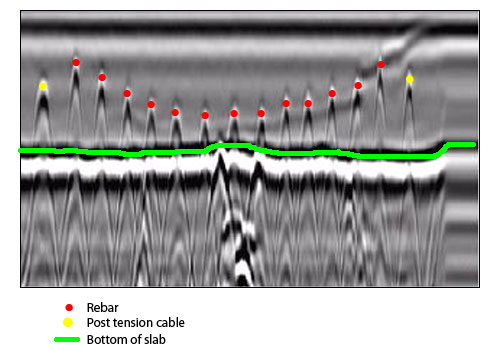Concrete Scanning: Your Shield Versus Unforeseen Obstacles in Building Projects
In the world of building, unpredicted obstacles can often interfere with timelines, spending plans, and security protocols. Nevertheless, with the evolution of concrete scanning innovations, the capability to prepare for and alleviate prospective barriers has actually ended up being a critical facet of task preparation and implementation. By taking advantage of the power of sophisticated scanning techniques, construction experts can proactively recognize concealed hazards beneath the surface area, guaranteeing a smoother and more reliable job distribution. As we discover the importance of concrete scanning as a protective shield versus unanticipated obstacles in building and construction tasks, a much deeper understanding of its applications and benefits emerges, clarifying the transformative influence it can carry the sector overall.
Value of Concrete Scanning
Concrete scanning plays a critical role in guaranteeing the security and stability of construction projects. By utilizing advanced innovations such as ground-penetrating radar (GPR) and electromagnetic induction, construction groups can properly locate rebar, post-tension cables, avenues, and other prospective obstructions within concrete frameworks. This procedure is necessary for stopping expensive damages, guaranteeing architectural security, and keeping job timelines.
Among the key reasons why concrete scanning is so vital is its ability to alleviate dangers during the building and construction stage. By identifying concealed threats under the surface area, such as voids or worn-out locations within the concrete, specialists can proactively resolve these concerns prior to they escalate right into more significant problems. This positive method not only boosts employee security but also decreases the possibility of construction hold-ups and budget plan overruns.
Furthermore, concrete scanning enables building and construction groups to make informed choices based on exact information. By having a clear understanding of the subsurface problems, task managers can intend excavation, drilling, or reducing activities much more efficiently, lowering the potential for unintended damage to vital architectural components. Ultimately, buying concrete scanning solutions is an aggressive step that can conserve construction companies time, money, and reputation in the future.
Advanced Technologies for Detection

One more innovative technology is Electromagnetic Induction (EMI), which detects metallic and non-metallic objects below ground by generating electro-magnetic areas. Additionally, Acoustic Pulse Echo (APE) modern technology utilizes audio waves to evaluate the problem of concrete structures and identify splits, gaps, or delaminations.
Additionally, improvements in infrared thermography have enabled the discovery of dampness infiltration and insulation spaces within concrete frameworks. This innovation help in preventing future deterioration and making sure the durability of building and constructions. By integrating these sophisticated innovations into concrete scanning techniques, building jobs can mitigate risks and improve total job results.
Benefits of Proactive Scanning
Applying proactive scanning strategies in building tasks boosts the early discovery of prospective subsurface obstacles, leading to enhanced job effectiveness and cost financial savings. By using concrete scanning technologies such as ground-penetrating radar (GPR) and electro-magnetic induction, building and construction groups can recognize surprise threats before they intensify right into expensive problems.
By determining prospective barriers early on, construction teams can take preventative steps to reduce dangers and guarantee a much safer working atmosphere for all included. Overall, the aggressive strategy to concrete scanning not only conserves time and money yet likewise improves the overall high quality and success of construction tasks.
Enhancing Job Performance
To optimize building and construction task end results, the proactive scanning methods employed not only improve safety but additionally play an important role in enhancing general task effectiveness. By carrying out complete concrete scanning before commencing any type of building and construction activities, prospective barriers and hazards below the surface can be recognized and alleviated at an early stage. This aggressive method lessens the possibility of costly delays, rework, and mishaps, hence simplifying the task timeline and budget.
By preemptively resolving any type of below ground intricacies, the building procedure can continue efficiently, with fewer interruptions and unanticipated obstacles. Ultimately, the assimilation of concrete scanning right into building and construction jobs not just makes sure safety and conformity yet likewise boosts productivity and job performance.
Ensuring Security On-Site
Security on construction sites is paramount to the success of any job. Guaranteeing safety on-site needs a detailed technique that entails proactive steps to avoid mishaps and mitigate risks. One of the crucial aspects of promoting security is giving sufficient training to all workers entailed in the task. Training should cover correct handling of devices, adherence to security methods, and emergency situation procedures. Routine security evaluations and audits ought to also be carried out to you can check here identify prospective dangers and address them quickly.
Implementing clear interaction networks for reporting safety click over here and security worries is crucial for producing a risk-free workplace. Urging a safety-first culture where workers feel equipped to speak out about prospective risks can help avoid crashes prior to they take place. In addition, giving individual safety equipment (PPE) and implementing its use is vital in securing employees from harm.
Conclusion

By including these advanced modern technologies right into concrete scanning techniques, building tasks can minimize threats and enhance overall task results.

In final thought, concrete scanning plays an important role in building tasks by view it now identifying unforeseen obstacles that might potentially impede progress and concession security on-site. GPR Concrete Scanning Bellevue.